Do Look Back
We humans have our eyes in the front of our heads. Stereoscopic vision worked great for our ancestors who hunted and gathered for food. It also works great to keep track of what is going on in front of us as we ride bicycles—a good thing since that is where more than 95% of crash threats are.
Eyes in the front of the head don’t work as well when we need to see what is behind.
Understandably, humans have primal fear of what approaches from behind. When we take this fear onto the roadway (fearing our fellow humans), it can cause us to misplace our attention. I’ll come back to this.
How can we have some peace of mind with what’s behind?
Thanks to skills, and equipment, I ride without fear on city streets and rural roads. You can too.

Number one skill is turning the head to look back. CyclingSavvy has an exercise for this in our Train Your Bike session. (You are actually training yourself, but it feels as though the bike is getting more cooperative…) You need to practice this until your are good at it. In the Train Your Bike session, one rider follows another in a straight line, holding up one to five fingers. The lead rider looks back and calls out the count of fingers.
The tough part of this exercise is to keep riding in a straight line. The organs of balance are inside your head, and the fluid in them sloshes around when you turn your head. It takes practice to compensate. Riding along a line in an empty parking lot lets you check on your progress.
There are several techniques for looking back without losing control of the bike.
Full rotation method: sit up straight, take one hand off the handlebar and rotate your shoulders as you look back. This technique not only gives you the best look, it shows your face to the driver behind you. And your hand is free to communicate (signal a left turn, ask the driver to stay back, or ask the driver to pass.)
Use a mirror to look back?
What if you have a stiff neck, or ride a recumbent bicycle so you can’t turn your head far enough?
Then you absolutely need a rear-view mirror.
Otherwise, the choice depends on your fear factor, and on where you ride. A bicyclist’s view is unobstructed to the rear, unlike that of other drivers — even motorcyclists with their bulky helmets. A mirror might not do much for you if you ride on paths and lightly-traveled streets with low speed limits.
In her recent post Nobody Expects a Bicyclist to Go Uphill at 20 Mph, Keri Caffrey recommends a mirror on rural two-lane roads, where she has to decide if and when release the travel lane.
I wouldn’t be without a mirror riding in urban traffic. A glance into the mirror every few seconds gives me uninterrupted front and rear situational awareness. More about that later.
A bicycle mirror may attach to the helmet, the handlebar or the eyeglasses. I prefer a helmet mirror. It is always there when I put on my helmet, and won’t get smashed if the bicycle falls over. But, different spokes for different folks. Want more details? John Brooking has an article about mirrors on this site, and Brian Watson has another.
Now, how to use a mirror. It shows what is behind you, not what is coming up next to you. Turning the head is still necessary, though not as far or for as long. My helmet mirror lets me scan side to side by turning my head slightly. The body does get in the way with a handlebar mirror, and so you have to turn your head all the way to look to the opposite side.
Other options
Your hearing can warn you that something is back there, but can’t confirm that nothing is there. Your hearing won’t warn you of a fast bicyclist about to pass you — or an e-bicyclist or e-scooterer, e-skateboarder, e-unicyclist. E-eeks! On paths too, whether legal or not!
A radar device sold to bicyclists bounces a signal off vehicles approaching from behind, and beeps warnings. Fine, if you don’t mind spending a few hundred dollars. The radar device will tell you that something is gaining on you, but it won’t advise on passing clearance. You still have to look back figure out what to do, a fact which its promotion neglects to mention. In heavy traffic, the radar device is useless because it has a “cry wolf” problem: too many warnings. All in all, a $20 rear-view mirror is more effective, once you have developed the skills to use it well.
The main reason to look back is to prepare to change lane position.
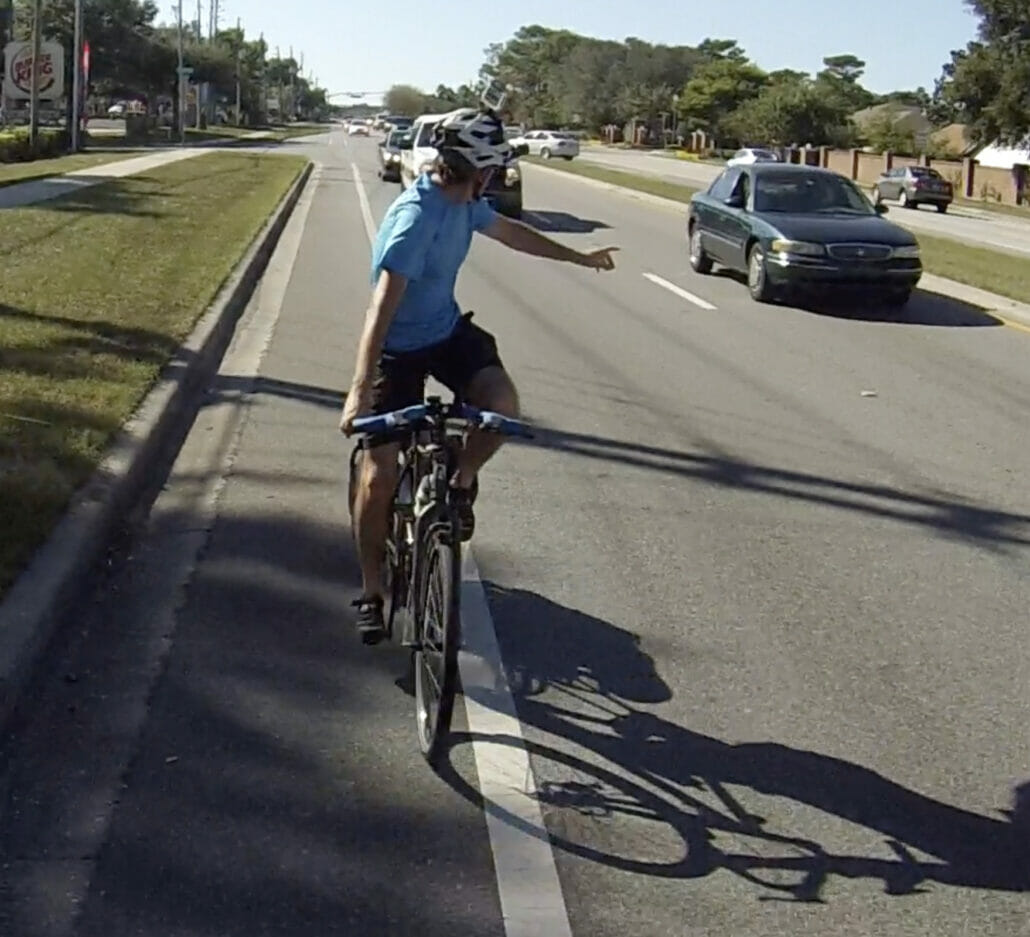
Clear communication is essential to handle this situation safely. Look back, well in advance, when you have time to make a hand signal to drivers of the first and second vehicle behind you. Or maybe there aren’t any vehicles behind you. Maybe there is only one, and you can slow slightly and let it pass, then merge. But if there is a line of traffic, make the hand signal. Look back again. The first driver will almost always let you into line. To avoid confusion and frustration, merge into line as soon as you can see that the driver has slowed to follow you. This is where becoming comfortable with a solid look-back is critical. You need to not only see the vehicle, but recognize when the driver is slowing to let you in.
By communicating with the driver, I get to know what kind of person I am dealing with in advance. The bicyclist who waits till the last moment to swerve out learns the hard way, during the actual pass.
Letting go and trying again
If a driver ignores your signal, you don’t want to deal with that person anyway. The next driver has more time to observe and react to you, and may even feel sympathy with you! Only rarely do I have to stop and let traffic pass when I would have liked to be let into line.
At any time, quick glances into the mirror are useful to scope out what is approaching from behind. A large truck needs a much longer lead time to slow than a small car. I might see that I can cross a lane in a gap and not have to negotiate with any driver. And so forth.
Turning the head signals to drivers behind me that I have looked and am aware of them. Often I’ll do it even if a shoulder check isn’t necessary.
You need to look back on paths too.
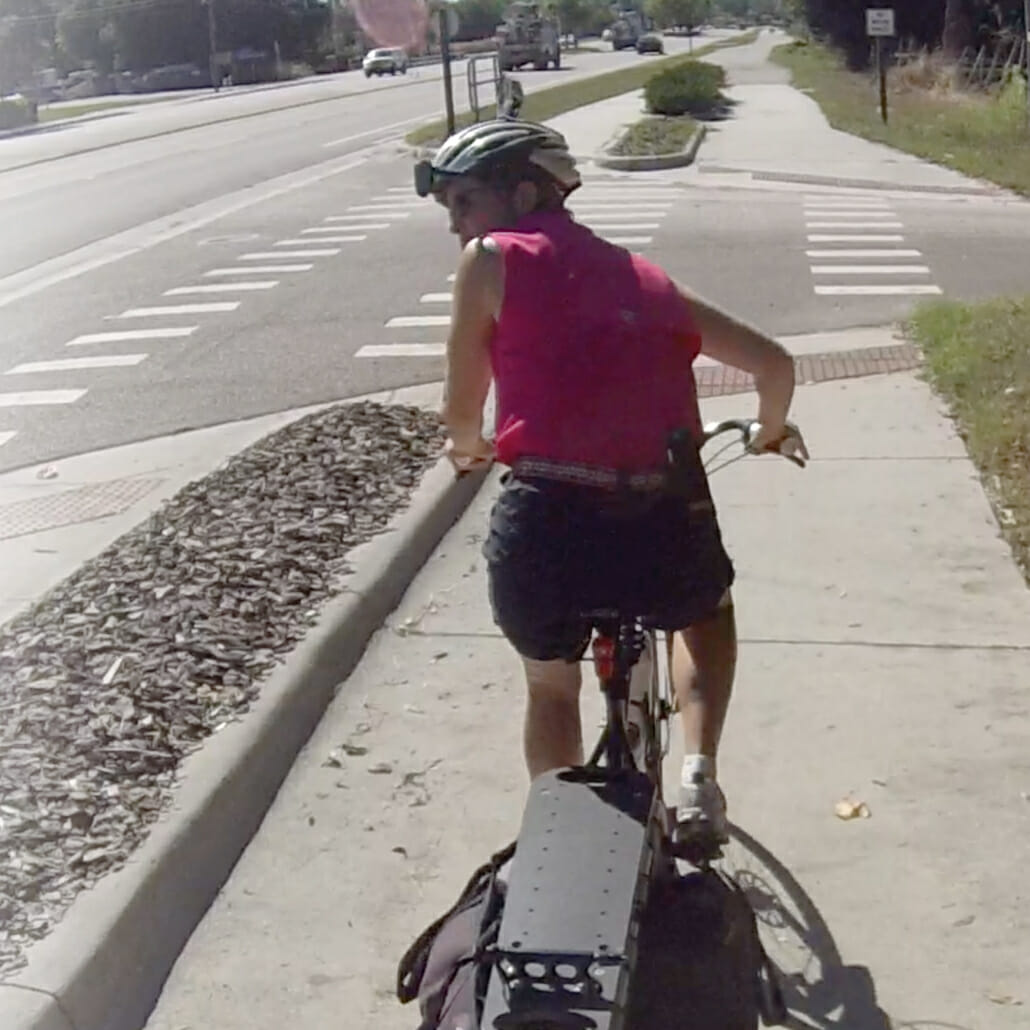
Though speeds are slower, paths are narrower than streets, and can be crowded: close passes are common. There will always be someone slower than you. It might be a little kid on a tricycle who is weaving and wandering. You need to look back before giving the kid a wide berth.
It’s also an essential skill for sidewalk and sidepath riding. You need to look back for turning vehicles coming from behind you (right or left hook).
Misplaced attention
Now let’s examine how riding on streets feels to a person who does not look back.
This bicyclist often will say “cars don’t see me.” That is a giveaway that the bicyclist does not think of the car as controlled by a driver. To this bicyclist, the car is an uncontrollable threat coming from behind. That prevents the bicyclist from communicating with the driver, as described earlier in this article.
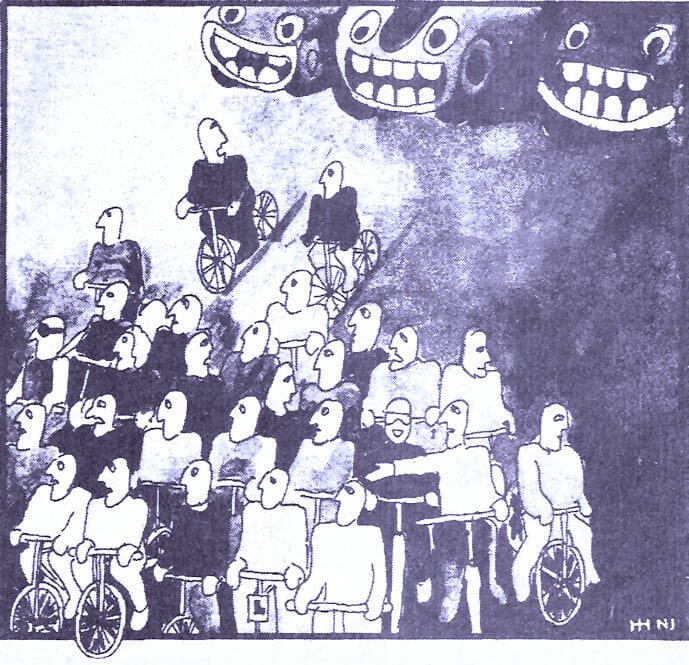
The image on the right, from the cover of a 1970s counterculture magazine, illustrates how many bicyclists think of their fellow road users. Only one of the 27 bicyclists in the picture is looking back — but also the cars have teeth for the radiator grille and big, hungry eyes for headlights. Believing that cars are uncontrolled can lead to this sick joke, that they are out to have bicyclists for dinner. Fear does arouse some primal instincts.
But a car is not the tiger chasing you. It is under the control of a driver, another human being like you. In the future, the driver may be a robotic controller, but it still amounts to the same thing: most drivers will act reasonable if you only show them what you want them to do.
Predictability + Communication = Cooperation
A bicyclist who believes that safety consists in staying out of the way as much as possible, then swerving out at the last moment around a parked vehicle or other obstacle, is asking a lot of a driver approaching from behind. This bicyclist is suddenly in the way. The driver failing to anticipate an unpredictable move may still react in time, but will be much angrier than a driver who waits a few seconds for a predictable and communicative bicyclist.
Bicyclists who misplace attention are more likely to experience close calls and angry honking, exacerbating the fear of cars motorists. It’s a vicious cycle.
If you are an adult of normal abilities, there’s no need to ride scared until some off-street utopia materializes. An informed understanding of risk, a recognition of your fellow road users as people, and a few simple skills will make your bicycling experience enjoyable.


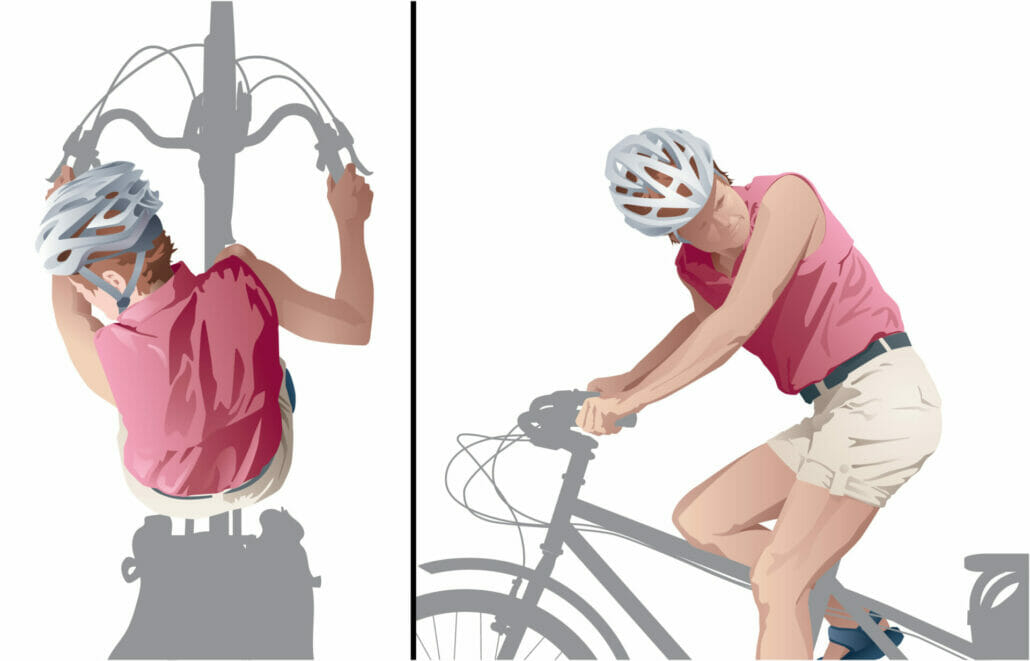
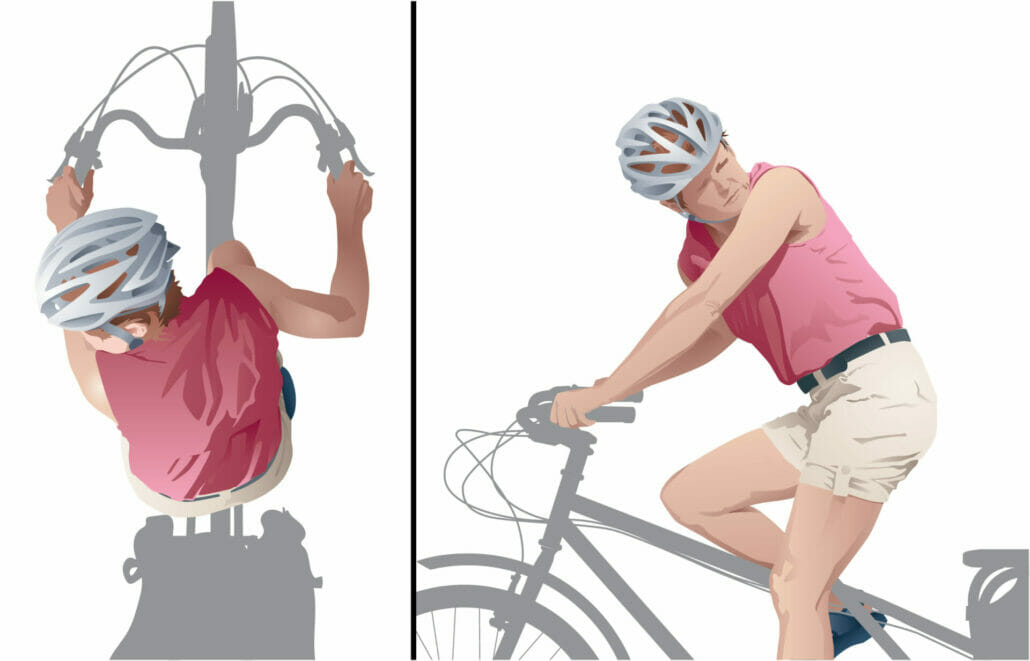
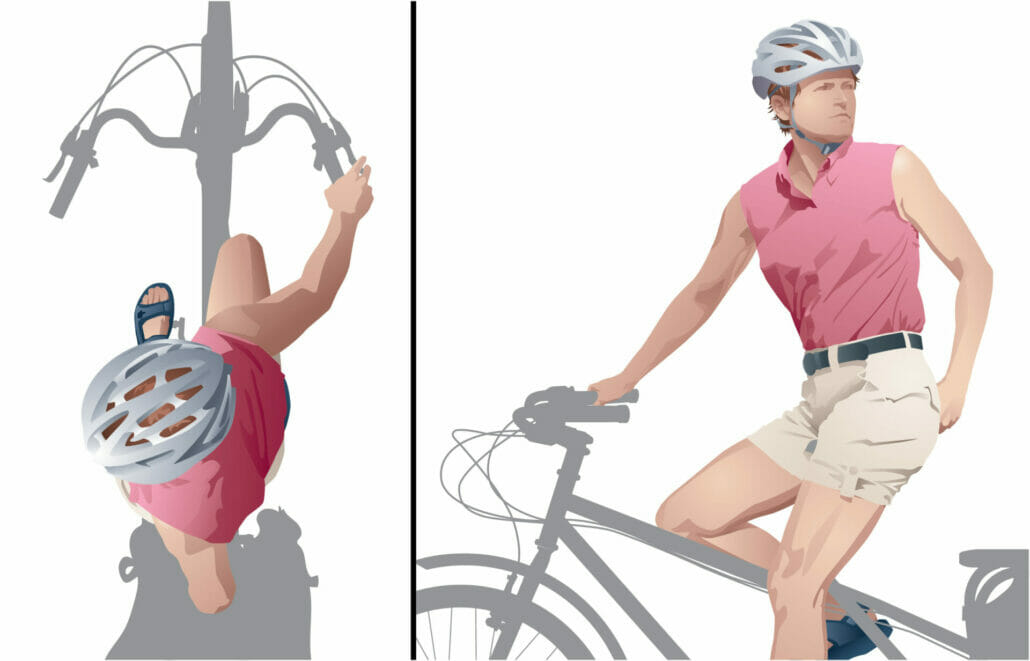



I love the line ” there’s no need to ride scared until some off-street utopia materializes.”
Knowledge of what’s happening around us can empower our movements. Turning to look can communicate our awareness and willingness to share with others.
I liked this statement “If a driver ignores your signal, you don’t want to deal with that person anyway.” This advice has been very helpful when going downhill approaching a single lane roundabout. Before I reach the speed of overtaking traffic, I look back for a friendly driver to slow and allow me to merge out of the Bike Lane. Occasionally, a motorist will maintain passing speed. It’s always easier to let them go and try the next driver. Thanks John.
I convinced a bike mirror company to abandon its tagline “Don’t look back” about 15 years ago. I don’t recall the name of the company, but I believe that they are no longer in business.
It was the type that was small and stuck to a cyclist’s glasses.